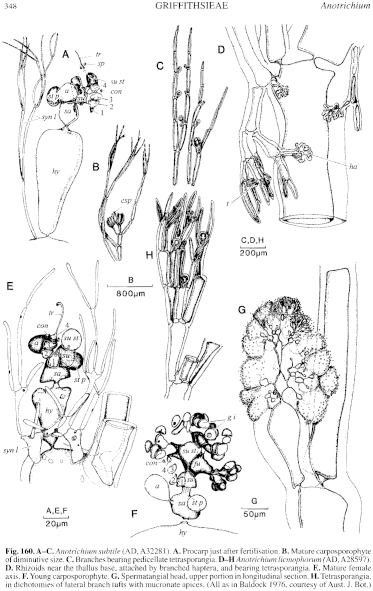|
|
|
|
|
|||||||||||
|
Electronic Flora of South Australia Species Fact Sheet
Phylum Rhodophyta – Order Ceramiales – Family Ceramiaceae – Tribe Griffithsieae
Selected citations: Lewis 1983: 262
Thallus (Fig. 157D) dark red, densely tufted, 2–9 cm high, filaments slender, subdichotomous with very fine terminal tufts, ecorticate throughout. Attached by basal rhizoids to jetty piles or pontoons, or epiphytic on seagrass. Structure. Cells near the thallus apex 18–30 µm in diameter and L/D 2–6, in mid thallus 44–92 µm in diameter and L/D 5.5–9, near thallus base 150–280 µm in diameter and L/D 4–5.
Reproduction: Gametophytes dioecious. Female axes (Fig. 160A) 3-celled, subapical, displaced laterally by the continued growth of the vegetative apical cell, flanked by 1–2 caducous, synchronic, hair-like laterals; procarp systems subapical, each with an abaxial, sterile, lateral cell, and adaxially a supporting cell bearing a sterile cell apically and a recurved, 4-celled carpogonial branch laterally; hypogenous cell enlarging at time of fertilisation, becoming ovoid-pyriform, 180–190 µm in diameter and L/D 1.5–2, and producing a whorl of 12–13 incurved, slender, 1-celled synchronic involucral branches, 75–114 µm in diameter and L/D 4–5 (Fig. 160B); fusion cell columnar, bearing 1–3 gonimolobes apically, most cells of which become small, ovoid carposporangia, 27–35 µm in diameter. Carposporophyte 150–400 µm across. Spermatangia in pyramidal heads (Fig. 157E) 75–100 µm in diameter and L/D 1.4–1.6, terminal on clavate pedicels 38–40 µm in diameter and L/D 1.4–1.6, produced singly and adaxially in upper thallus branches.
Tetrasporangia (Fig. 160C) single, terminal on cylindrical pedicels 26–29 µm in diameter and L/D 1–1.3 produced adaxially in groups of 1–3 from the upper shoulder of most cells near the thallus apex, globose, 50–90 µm in diameter, tetrahedrally divided.
Type from Semaphore, S. Aust., on jetty piles, upper sublittoral (Nielsen, 16.iii.1968); holotype in AD, A32281.
Selected specimens: Port Adelaide, S. Aust., 2–10 cm deep on pontoon (Leopold, 12.iv.1984; AD, A55111). Botany Bay, N.S.W., on Posidonia, drift (Womersley, 20.v.1978; AD, A49371).
Distribution: Known from Gulf St Vincent, S. Aust., Port Phillip Bay, Vic., (Lewis 1983, p. 257) and Botany Bay, N.S.W.
Taxonomic notes: A. subtile occurs in calmer waters of bays, often on artificial substrates, and differs from other Australian species in the extremely slender filaments and small reproductive organs. Vegetative features are similar to Griffithsia (Anotrichium) multiramosa (Setchell & Gardner) Taylor (1939, p. 14) from Baja California which is known only from tetrasporangial plants; however, the cells are smaller and branching less dense in A. subtile.
References:
BALDOCK, R.N. (1976). The Griffithsieae group of the Ceramiaceae (Rhodophyta) and its southern Australian representatives. Aust. J. Bot. 24, 509–593.
LEWIS, J.A. (1983). Floristic composition and periodicity of subtidal algae on an artificial structure in Port Phillip Bay (Victoria, Australia). Aquatic Bot. 15, 257–274.
TAYLOR, W.R. (1939). Algae collected on the Presidential cruise of 1938. Smithsonian Misc. Coll. 98, 1–18, Plates 1, 2.
The Marine Benthic Flora of Southern Australia Part IIIC complete list of references.
Publication:
Womersley, H.B.S. (24 December, 1998)
The Marine Benthic Flora of Southern Australia
Rhodophyta. Part IIIC. Ceramiales – Ceramiaceae, Dasyaceae
©State Herbarium of South Australia, Government of South Australia
Illustrations in Womersley Part IIIA, 1998: FIGS 157D, E, 160 A–C.

Figure 157 enlarge
Fig. 157. A. Anotrichium tenue var. thyrsigerum (AD, A26364). Habit. B, C. Anotrichium towinna (AD, A28222). B. Habit. C. Detail of main axes and whorls of laterals with divergent branches. D, E. Anotrichium subtile (AD, A32281). D. Habit. E. Spermatangial head.

Figure 160 enlarge
Fig. 160. A–C. Anotrichium subtile (AD, A32281). A. Procarp just after fertilisation. B. Mature carposporophyte of diminutive size. C. Branches bearing pedicellate tetrasporangia. D–H Anotrichium licmophorum (AD, A28597). D. Rhizoids near the thallus base, attached by branched haptera, and bearing tetrasporangia. E. Mature female axis. F. Young carposporophyte. G. Spermatangial head, upper portion in longitudinal section. H. Tetrasporangia, in dichotomies of lateral branch tufts with mucronate apices. (All as in Baldock 1976, courtesy of Aust. J. Bot.)

|
Email Contact: State Herbarium of South Australia |

|